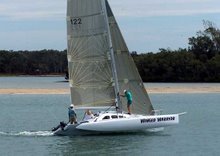 I got the Ronstan Carbon triple blocks for the mainsheet, just trying them out with some dyneema sk 75, this is for the big purchase, finetune is the same just a two block also with a cleat.
I got the Ronstan Carbon triple blocks for the mainsheet, just trying them out with some dyneema sk 75, this is for the big purchase, finetune is the same just a two block also with a cleat.
New gloves, great protection and good feeling.
People tend to use latex gloves.....LATEX MATERIAL IS NOT GOOD ENOUGH.......use nitril, and heavy duty if the job last for long or change gloves.
 Here is the setup I use, white protection suit and gloves.
Here is the setup I use, white protection suit and gloves.


























































